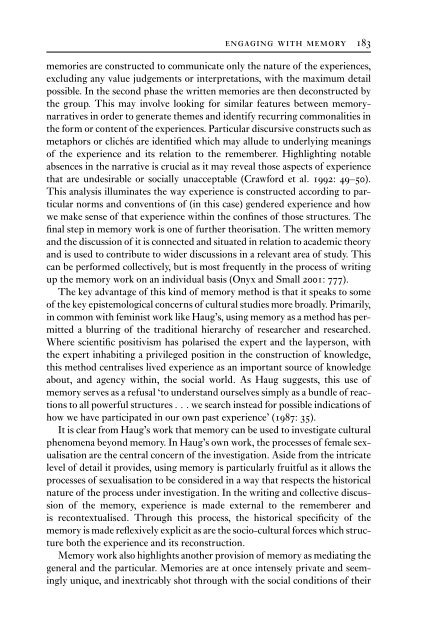Research Methods for Cultural Studies
Research Methods for Cultural Studies
Research Methods for Cultural Studies
You also want an ePaper? Increase the reach of your titles
YUMPU automatically turns print PDFs into web optimized ePapers that Google loves.
engaging with memory 183<br />
memories are constructed to communicate only the nature of the experiences,<br />
excluding any value judgements or interpretations, with the maximum detail<br />
possible. In the second phase the written memories are then deconstructed by<br />
the group. This may involve looking <strong>for</strong> similar features between memorynarratives<br />
in order to generate themes and identify recurring commonalities in<br />
the <strong>for</strong>m or content of the experiences. Particular discursive constructs such as<br />
metaphors or clichés are identified which may allude to underlying meanings<br />
of the experience and its relation to the rememberer. Highlighting notable<br />
absences in the narrative is crucial as it may reveal those aspects of experience<br />
that are undesirable or socially unacceptable (Craw<strong>for</strong>d et al. 1992: 49–50).<br />
This analysis illuminates the way experience is constructed according to particular<br />
norms and conventions of (in this case) gendered experience and how<br />
we make sense of that experience within the confines of those structures. The<br />
final step in memory work is one of further theorisation. The written memory<br />
and the discussion of it is connected and situated in relation to academic theory<br />
and is used to contribute to wider discussions in a relevant area of study. This<br />
can be per<strong>for</strong>med collectively, but is most frequently in the process of writing<br />
up the memory work on an individual basis (Onyx and Small 2001: 777).<br />
The key advantage of this kind of memory method is that it speaks to some<br />
of the key epistemological concerns of cultural studies more broadly. Primarily,<br />
in common with feminist work like Haug’s, using memory as a method has permitted<br />
a blurring of the traditional hierarchy of researcher and researched.<br />
Where scientific positivism has polarised the expert and the layperson, with<br />
the expert inhabiting a privileged position in the construction of knowledge,<br />
this method centralises lived experience as an important source of knowledge<br />
about, and agency within, the social world. As Haug suggests, this use of<br />
memory serves as a refusal ‘to understand ourselves simply as a bundle of reactions<br />
to all powerful structures . . . we search instead <strong>for</strong> possible indications of<br />
how we have participated in our own past experience’ (1987: 35).<br />
It is clear from Haug’s work that memory can be used to investigate cultural<br />
phenomena beyond memory. In Haug’s own work, the processes of female sexualisation<br />
are the central concern of the investigation. Aside from the intricate<br />
level of detail it provides, using memory is particularly fruitful as it allows the<br />
processes of sexualisation to be considered in a way that respects the historical<br />
nature of the process under investigation. In the writing and collective discussion<br />
of the memory, experience is made external to the rememberer and<br />
is recontextualised. Through this process, the historical specificity of the<br />
memory is made reflexively explicit as are the socio-cultural <strong>for</strong>ces which structure<br />
both the experience and its reconstruction.<br />
Memory work also highlights another provision of memory as mediating the<br />
general and the particular. Memories are at once intensely private and seemingly<br />
unique, and inextricably shot through with the social conditions of their


